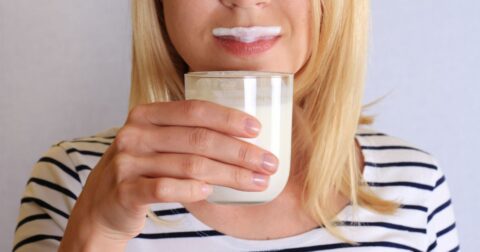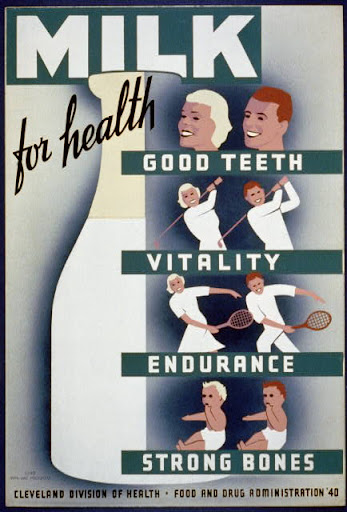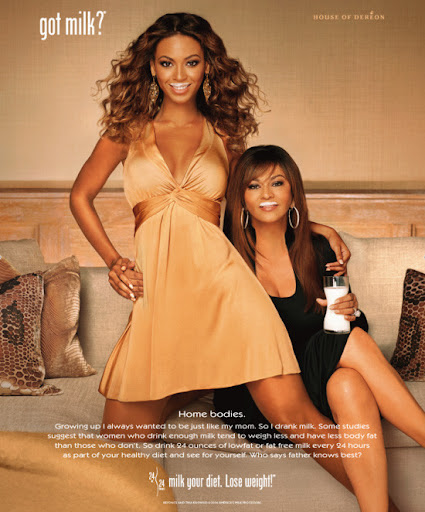Investigation
Oklahoma’s Loophole: How Tyson’s Water Use Goes Unchecked
Food•15 min read
Reported
The Aubrey Plaza campaign is just the latest in a long history of artists, celebrities and athletes hired to promote the dairy industry.


Words by Marlena Williams
“Have you ever looked at a tree and thought, ‘Can I drink this?’”
So begins the dairy industry’s most recent advertising campaign, Wood Milk, which aims to satirize the popularity of plant-based milk alternatives and reinstate dairy milk as the truly hip and healthy beverage option for American consumers. In the ad, actress Aubrey Plaza poses as the co-founder of “the world’s first and only milk made from wood,” a chunky sludge packaged in trendy, earth-toned cartons boasting flavors like “Oak” and “Mahogany.”
Funded by the Washington, DC-based advertising agency MilkPEP, the campaign is partly a response to the FDA’s draft guidelines giving plant-based alternatives permission to call themselves milk, so long as their nutritional differences are clearly marked on the label.
As dairy milk consumption continues its decades-long decline, the Wood Milk campaign is sleekly designed to raise doubts about the health and safety of plant-based milks (we are told that Wood Milk is not “born” but “squished into a slime that is legal to sell”) while portraying consumers of plant-based milks as gullible, out-of-touch elites who gulp down highly artificial dairy alternatives without knowing anything about their nutritional benefits.
The ad, which premiered only a week after 18,000 cows were killed in a massive explosion at a Texas dairy farm, received immediate backlash from critics calling both the campaign and Plaza herself desperate, tone-deaf and out-of-touch. Wood Milk has since turned off comments on the original YouTube video, which has nearly six million views.
But in many ways, the Wood Milk campaign is nothing new. In fact, it is part of a long tradition of the dairy industry enlisting artists, celebrities and athletes to promote milk in the face of public distrust and flagging demand.

It’s easy to assume that dairy milk has always been a staple of a balanced American diet. But before dairy milk garnered its reputation as a nutritional powerhouse, it was seen as a pressing public health threat.
Before the nineteenth century, most dairy products were produced on local, family-owned farms with herds as small as one or two cows. As more and more of the population poured into cities throughout the century, however, mass-produced milk quickly became the norm.
In order to satisfy this growing demand, dairy producers packed hundreds of cows into filthy, unventilated stables where the cows seldom survived for longer than six months. Because many urban stables were located next to breweries and distilleries, producers often fed their cows the leftovers from beer and whiskey production, leading to a bluish, illness-inducing milk nicknamed “swill milk,” which had to be thickened with chalk and tinted in order to appear drinkable. Cows living in these horrid conditions soon developed tuberculosis and other deadly diseases that were then transmitted to consumers, particularly infants and young children.
To make matters worse, raw milk was sold in crowded city streets out of open buckets that gathered dirt, leaves and other bacteria as unwitting buyers dipped into the liquid with a shared ladle. Even as late as 1913, a typhoid epidemic in New York City was linked to contaminated milk. Though milk-borne illnesses were predominantly an urban issue, people living in Midwestern and Plains states were also known to die from “milk sickness” after drinking the milk of cows that had consumed poisonous plants.
Throughout the late 1800s, doctors, health officials and concerned citizens began pushing for reforms, including improved living conditions for cows, state laws regulating milk purity and certification requirements for milk producers. New technologies like pasteurization, glass bottles and refrigerated milk tankers also helped to improve the safety and quality of milk, and stemmed the growing crisis. Early advertisements strived to ensure consumers that pasteurization would keep children safe without sacrificing the milk’s creamy taste.
Industry messaging increasingly linked milk with maintaining strong and healthy families, and often took on blatantly racist overtones. In 1923, future President Herbert Hoover addressed the World Dairy Congress, declaring, “Upon this industry, more than any other of the food industries, depends not alone the problem of public health but there depend on it the very growth and virility of the white race.”
But milk couldn’t quite shake its reputation as a dubious beverage. According to the book Milk: A 10,000 Year History by historian Mark Kulasky, even as the dairy industry dramatically expanded throughout the early twentieth century, milk consumption remained out-of-step with the increasing scale of production.
When demand dropped during the Great Depression, the federal government stepped in to stabilize prices and stoke milk consumption with the help of struggling artists. As part of the Works Progress Administration, or WPA, the federal government paid artists to design dairy advertisements like the one pictured above, which depicts a smiling white couple swinging tennis rackets and golf clubs alongside the text, “Milk For Health: Good Teeth, Vitality, Endurance, Strong Bones.” Milk was glorified as a kind of miracle beverage, capable of both keeping you warm in the winter and cooling you off in the summer.
These ads helped to set the template for milk advertising in the coming decades. By mid-century, the American Dairy Association began producing print and television ads that promoted milk as an essential source of vitality, lasting energy and weight-loss. In the early 1960s, the American Dairy Association even became the official sponsor of the popular family sitcom The Adventures of Ozzie & Harriet. During commercial breaks, the show’s cheery, all-American stars would return to the screen and encourage viewers to drink a glass of milk with every meal.
But the atomic age brought its own host of concerns about the health and safety of milk. During the late 1950s, many consumers avoided milk out of fear that dairy cows were eating grass that had been contaminated by radioactive materials like strontium-90 and iodine-13, which were linked to cancers, bone loss and premature aging.
Advertisements touting the numerous health benefits of milk failed to silence public concern about milk’s possible health risks. In fact, milk consumption peaked in 1945 — and has been falling ever since.
Despite declining consumption, advertisers tried a wide variety of tactics to keep milk in American fridges. In 1984, the National Dairy Board launched “Milk: It Does A Body Good,” a campaign designed to promote dairy milk as the key to strong bones, healthy joints, and an attractive body. In the commercials, young boys and girls chat up their crushes while drinking milk and slowly transforming into fit and beautiful adults.
But by the early 1990s, Americans were still only drinking about .78 cups of milk a day. Desperate to boost sales, the California Milk Processing Board, or CMPB, enlisted the help of San Francisco-based advertising firm Goodby, Silverstein & Partners, and the legendary Got Milk? campaign was born.
The first stage of the Got Milk? campaign was based around the concept of deprivation: milk isn’t something consumers appreciate…until it isn’t there. The first commercial, which premiered in 1993, featured a frenzied historian calling into a radio quiz show to win a $10,000 cash prize. As he opens his mouth to answer, he realizes his mouth is coated in peanut butter and, with no milk to wash it down with, he is unable to say the winning words: Aaron Burr. The memorable commercial was directed by Michael Bay, the man behind mega-blockbusters like Armageddon and Transformers.
In 1995, the CMPB partnered with Mattel to release the Got Milk? Barbie, which came with its own pink straw for sipping milk “in style.” That same year, MilkPEP, the future creators of the Wood Milk campaign, introduced the now-iconic milk mustache in a print ad, featuring model Naomi Campbell. Shortly thereafter, MilkPEP licensed the “Got Milk?” slogan and the two campaigns essentially became one.
In the years that followed, countless A-list stars posed for dairy ads. Over 180 of the Got Milk? advertisements were photographed by famed photographer Annie Leibovitz. Actors like Harrison Ford and Jennifer Aniston, musicians like Britney Spears and Beyoncé, models like Kate Moss and Tyra Banks, and athletes like Serena Williams and Dennis Rodman have all been featured in the Got Milk? campaign over the years.

The ads continued to extol milk as the key to strong bones, even after a highly-publicized 1997 study from Harvard suggested that milk consumption actually did little to support long-term bone health.
Though Got Milk? is widely considered to be one of the greatest ad campaigns of all time, it didn’t actually have much impact on consumer behavior. In the years since the campaign began, milk consumption has further declined to just .49 cups a day. In the end, the Got Milk? campaign was more memorable than it was effective.
As the Got Milk? campaign wrapped in the early 2010s, dairy advertisers began searching for new marketing ploys. With plant-based alternatives growing in popularity, dairy advertisers seized on almond, oat, and coconut milks as easy targets for their new marketing push.
In 2012, the CMPB once again teamed up with Goodby, Silverstein & Partners to produce “The Science of Imitation Milk,” in which youthful contestants on a fake game show attempt to guess the mysterious, artificial ingredients of “imitation” milks. The ad aims to convince consumers that plant-based milks are chock-full of unpronounceable, unhealthy additives and insists, despite evidence showing that plant-based milks have been around for centuries, that only cow’s milk is “really” milk.
Milk processors do have reason to be nervous. At the end of 2020, sales of plant-based milk in the United States totaled $2.5 billion, and that number is only expected to climb. By the end of 2026, plant-based milks are projected to account for 30 percent of all milk sales nationwide.
At the same time, dairy milk consumption continues to drop. From 2010 to 2017, per capita dairy milk consumption fell at a rate of almost 2.5 percet per year. According to a study from the USDA’s Economic Research Service, every gallon of plant-based milk bought by American households replaces the equivalent gallon of dairy milk.
There are many reasons why consumers may be picking plant-based milks over dairy. Nearly 70 percent of the world’s population is estimated to have what’s called lactose malabsorption, which can lead to lactose intolerance, and unsweetened, fortified soy milk provides similar nutritional benefits to dairy milk.
Growing awareness about the cruelty and environmental impact of dairy farming likely motivate conscious consumers to choose more humane, climate-friendly alternatives. Many people also simply prefer the taste of plant-based milks. And though plant-based alternatives have become an easy and convenient target for the dairy industry, they hardly explain all of milk consumption’s continuing decline.
Concerns about the health and safety of dairy milk have lingered for centuries. Though dairy ads like “The Science of Imitation Milk” and “Wood Milk” suggest that plant-based milks pose a novel threat to a healthy and hearty all-American beverage, the history suggests otherwise. The public has never been entirely sold on dairy milk, and it doesn’t seem like another flashy advertising campaign featuring a popular celebrity is going to change that any time soon.